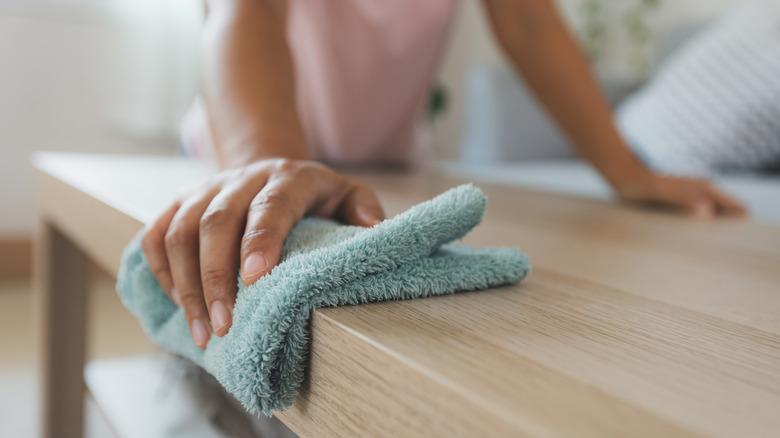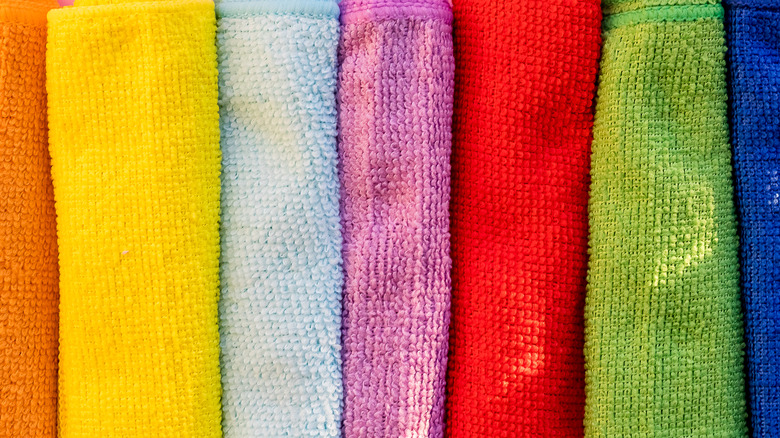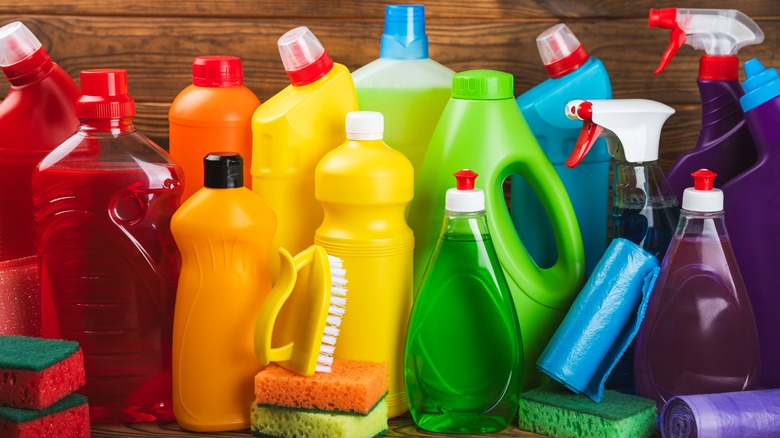The Microfiber Towel Color Coding Tip You'll Want To Use To Clean Your Home
Of the many genius cleaning tools you absolutely need for your home, microfiber cloths top the list thanks to their ability to pick up and hold more than other cleaning tools. This is thanks to microscopic hooks at the end of the fibers, added surface area due to the design, and positive electrical charge that attracts dirt and grime. Using color-coded cleaning cloths is an essential method that commercial and professional cleaners have been practicing for decades to maintain hygiene standards. By assigning a specific color of cloth to an area or task, you can avoid cross-contamination by preventing the same cloth from being used in areas where you would not want to transfer dangerous forms of bacteria, such as from your toilet to your kitchen counter.
Maintaining and organizing your microfiber collection is key to keeping this color-coded cleaning system working seamlessly and efficiently, so be sure to avoid common laundry mistakes that can ruin your microfiber cloths by washing them correctly, and use a system for organizing your colorful cloths by using bins, or this affordable Dollar Tree mesh organizer to keep your cleaning towels clutter-free, as well as easy to see and access. Follow the lead of cleaning professionals and implement color coding for your microfiber cloths at home, designating one color per area or type of surface, to keep your home cleaner and safer.
Color coding your microfiber cleaning cloths
Begin by purchasing a rainbow pack of microfiber towels so you have a variety of hues to choose from. Though you can set up your color coding system with whichever colors you'd prefer, there is a science to the visual cues certain colors give off, so it is recommended you go in the order of level of hazard to help remember which colors are for which areas.
Starting with the tamest, use blue towels for mirrors and glass. Green microfiber cloths should be used for the kitchen, food prep areas, and general non-bathroom areas. Yellow shows a bit of warning, so use this for the tamer bathroom surfaces such as sinks, faucets, vanities, and showers. Red screams hazard, so use these for areas like toilets and urinals (then wash immediately after use since the cloth can hold bacteria). Finally, for floors, gross messes, and outdoors, switch to non-microfiber white cloths or rags that can be bleached (which can damage microfiber cloths).
You may want to further split out other areas specific to your needs, so you will need additional cloth colors. For example, black is perfect for garage maintenance, gray is the obvious choice for stainless steel cleaner, and white is ideal for blotting upholstery stains. Some people prefer a wood polishing or dusting cloth separate from the kitchen, while others may want a separate cloth for another space in the home, like the laundry room. Tailor your color coding to your specific routine.
Taking color-coded cleaning a step further
Another great way to help remember which cloths go with which cleaners is to color code the cleaning products, too. Consider replacing the sprayer heads on the bottles with color coded options that match the corresponding cloths. Alternatively, use reusable silicone bottle labels to slide around your cleaning products to match the color of the microfiber cloth you want to use with it. Both of these options are removable when the product runs out, and can be placed on a new bottle.
If you would prefer to go all-in and either make your own cleaners or use concentrates, color-coded glass bottles are a perfect fit for your new system. You can choose the color for each type of cleaner, as well as customize the text label to match the type. This is a double visual cue to grab the correct cloth for the job, and keep your cleaning routine clear and organized.


